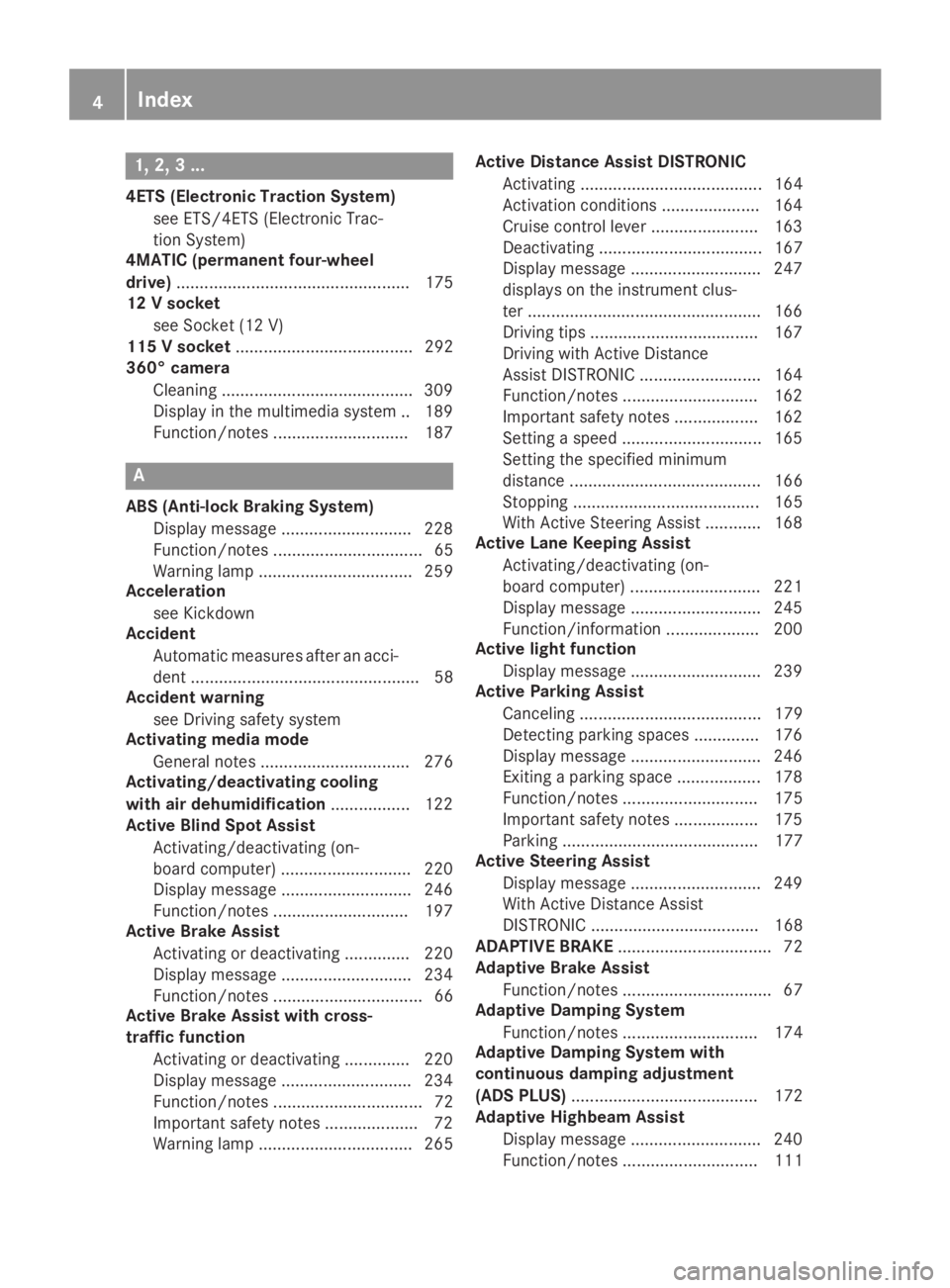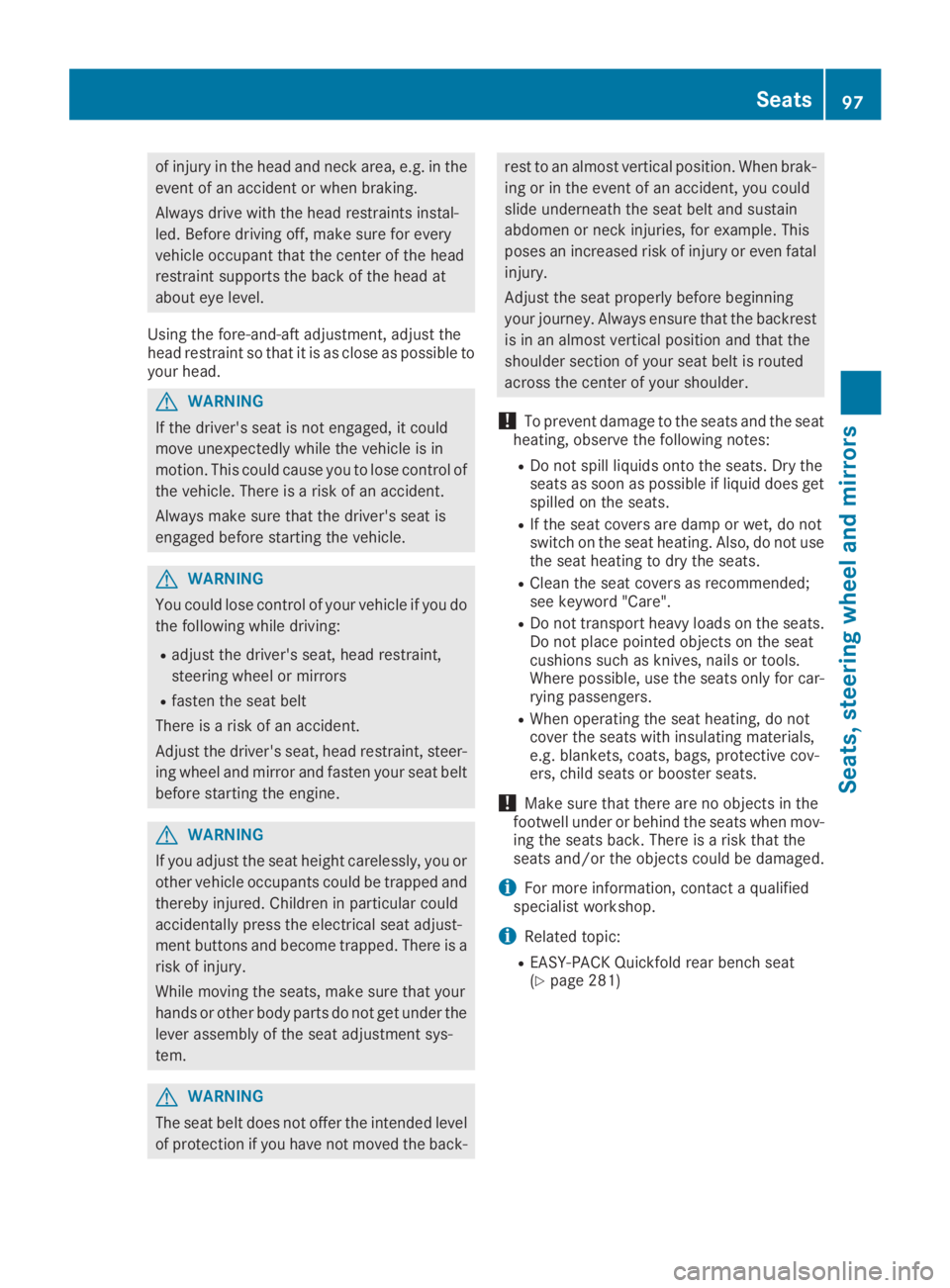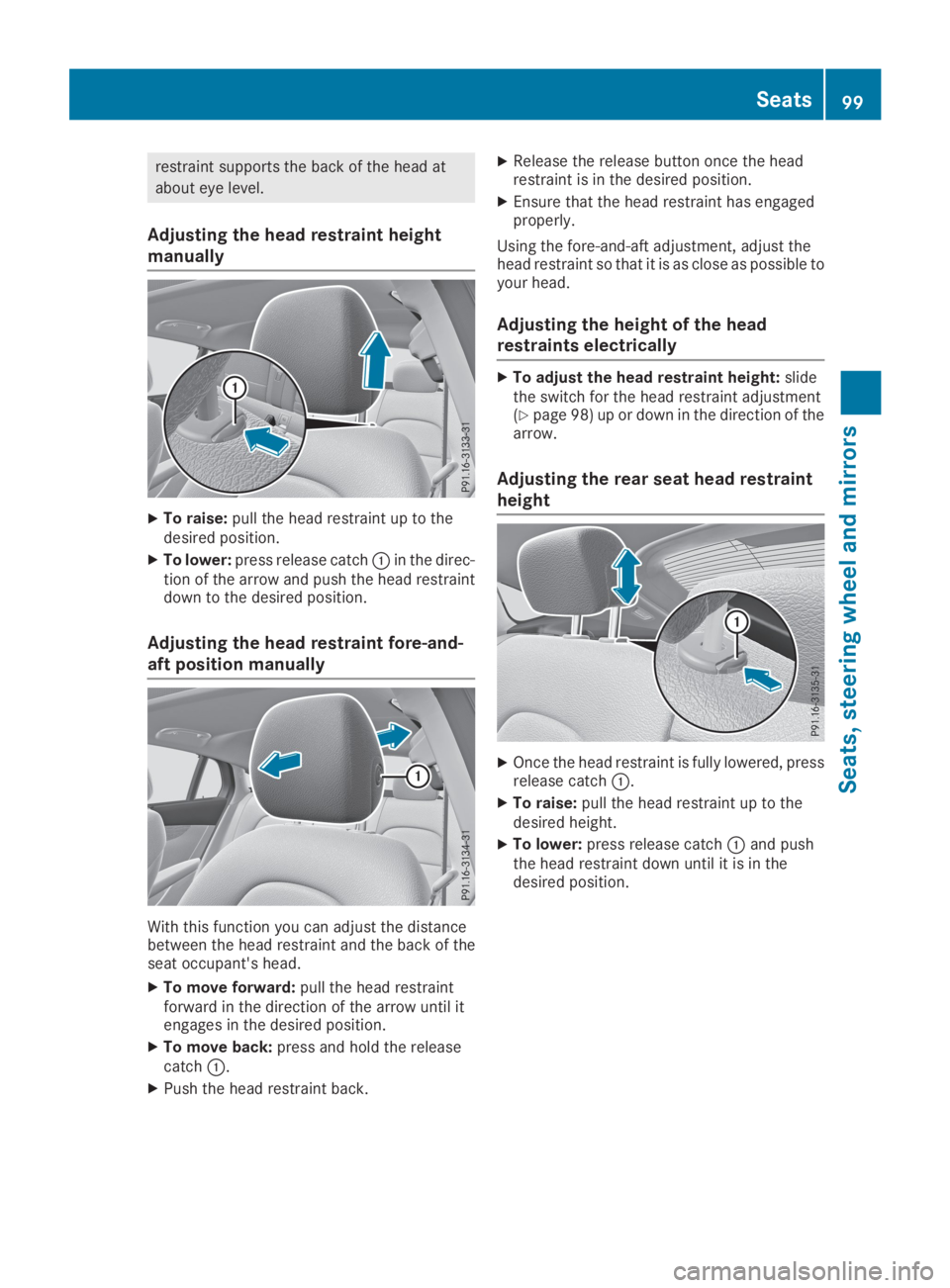steering wheel adjustment MERCEDES-BENZ GLC 2019 Owners Manual
[x] Cancel search | Manufacturer: MERCEDES-BENZ, Model Year: 2019, Model line: GLC, Model: MERCEDES-BENZ GLC 2019Pages: 370, PDF Size: 19.55 MB
Page 6 of 370

1, 2, 3 ...
4ETS (Electronic Traction System)
see ETS/4ETS (Electronic Trac-
tion System)
4MATIC (permanent four-wheel
drive).................................................. 175
12 V socket
see Socket (12 V)
115 V socket...................................... 292
360° camera
Cleaning .........................................309
Display in the multimedia system .. 189
Function/notes .............................187
A
ABS (Anti-lock Braking System)
Display message ............................ 228
Function/notes ................................ 65
Warning lamp ................................. 259
Acceleration
see Kickdown
Accident
Automatic measures after an acci-
dent ................................................. 58
Accident warning
see Driving safety system
Activating media mode
General notes ................................ 276
Activating/deactivating cooling
with air dehumidification................. 122
Active Blind Spot Assist
Activating/deactivating (on-
board computer) ............................ 220
Display message ............................ 246
Function/notes .............................197
Active Brake Assist
Activating or deactivating .............. 220
Display message ............................ 234
Function/notes ................................ 66
Active Brake Assist with cross-
traffic function
Activating or deactivating .............. 220
Display message ............................ 234
Function/notes ................................ 72
Important safety notes .................... 72
Warning lamp ................................. 265
Active Distance Assist DISTRONIC
Activating ....................................... 164
Activation conditions ..................... 164
Cruise control lever ....................... 163
Deactivating ................................... 167
Display message ............................ 247
displays on the instrument clus-
ter ..................................................166
Driving tips ....................................167
Driving with Active Distance
Assist DISTRONIC .......................... 164
Function/notes .............................162
Important safety notes .................. 162
Setting a speed .............................. 165
Setting the specified minimum
distance ......................................... 166
Stopping ........................................ 165
With Active Steering Assist ............ 168
Active Lane Keeping Assist
Activating/deactivating (on-
board computer) ............................ 221
Display message ............................ 245
Function/information.................... 200
Active light function
Display message ............................ 239
Active Parking Assist
Canceling ....................................... 179
Detecting parking spaces .............. 176
Display message ............................ 246
Exiting a parking space .................. 178
Function/notes............................. 175
Important safety notes .................. 175
Parking .......................................... 177
Active Steering Assist
Display message ............................ 249
With Active Distance Assist
DISTRONIC .................................... 168
ADAPTIVE BRAKE................................. 72
Adaptive Brake Assist
Function/notes................................ 67
Adaptive Damping System
Function/notes............................. 174
Adaptive Damping System with
continuous damping adjustment
(ADS PLUS)........................................ 172
Adaptive Highbeam Assist
Display message ............................ 240
Function/notes............................. 111
4Index
Page 50 of 370

The seat belt adjustment will apply a certaintightening force if any slack is detected betweenthe vehicle occupant and the seat belt. Do notgrab hold of the seat belt.
You can switch the seat belt adjustment on andoff using the multimedia system. Information onswitching the seat belt adjustment on and offcan be found in the Digital Operating Instruc-tions.
Belt warning for the driver and front
passenger
The�vseat belt warning lamp in the instru-ment cluster is a reminder that all vehicle occu-pants must wear their seat belts. It may light upcontinuously or flash. In addition, there may bea warning tone.
Regardless of whether the driver's seat belt hasalready been fastened, the�vseat belt warn-ing lamp lights up for six seconds each time theengine is started. If the front doors are closedand the driver's or front-passenger seat belt hasnot been fastened, the�vseat belt warninglamp lights up again after the six seconds. Assoon as the driver's and front-passenger seatbelts are fastened or a front door is openedagain, the�vseat belt warning lamp goes out.
If the driver's seat belt is not fastened after theengine is started, an additional warning tone willsound. The warning tone switches off after sixseconds or once the driver's seat belt is fas-tened.
If the vehicle's speed exceeds 15 mph(25 km/h)once and the driver's and front-passenger seat belts are not fastened, a warningtone sounds. A warning tone also sounds withincreasing intensity for 60 seconds or until thedriver or front passenger have fastened theirseat belts.
If the driver or front passenger unfasten theirseat belts during the journey, the seat belt warn-ing is activated again.
Air bags
Introduction
The installation point of an air bag can be rec-ognized by the AIRBAG marking.
An air bag complements the correctly fastenedseat belt. It is no substitute for the seat belt. The
air bag provides additional protection in appli-cable accident situations.
Not all air bags are deployed in an accident. Thedifferent air bag systems function independ-ently from one another (Ypage 55).
However, no system available today can com-pletely eliminate injuries and fatalities.
It is also not possible to rule out a risk of injurycaused by an air bag due to the high speed atwhich the air bag must be deployed.
Important safety notes
GWARNING
If you do not sit in the correct seat position,
the air bag cannot protect as intended and
could even cause additional injury when
deployed. This poses an increased risk of
injury or even fatal injury.
To avoid hazardous situations, always make
sure that all of the vehicle's occupants:
Rhave fastened their seat belts correctly,
including pregnant women
Rare sitting correctly and maintain the great-
est possible distance to the air bags
Rfollow the following instructions
Always make sure that there are no objects
between the air bag and the vehicle's occu-
pants.
RAdjust the seats properly before beginningyour journey. Always make sure that the seatis in an almost upright position. The center ofthe head restraint must support the head atabout eye level.
RMove the driver's and front-passenger seatsas far back as possible. The driver's seat posi-tion must allow the vehicle to be driven safely.
ROnly hold the steering wheel on the outside.This allows the air bag to be fully deployed.
RAlways lean against the backrest while driv-ing. Do not lean forward or lean against thedoor or side window. You may otherwise be inthe deployment area of the air bags.
RAlways keep your feet in the footwell in frontof the seat. Do not put your feet on the dash-
48Occupant safety
Safety
Page 60 of 370

PRE-SAFE®takes the following measuresdepending on the hazardous situation detected:
Rthe front seat belts are pre-tensioned.
Rif the vehicle skids, the side windows and thesliding sunroof are closed.
Rvehicles with the memory function for thefront-passenger seat: the front-passengerseat is adjusted if it is in an unfavorable posi-tion.
If the hazardous situation passes without result-
ing in an accident, PRE-SAFE®slackens the belt
pre-tensioning. All settings made by PRE-SAFE®
can then be reversed.
If the seat belt pre-tensioning is not reduced:
XMove the seat backrest or seat back slightlywhen the vehicle is stationary.The seat belt pre-tensioning is reduced andthe locking mechanism is released.
The seat-belt adjustment is an integral part of
the PRE-SAFE®convenience function. Informa-tion about the convenience function can befound under "Belt adjustment" (Ypage 47).
PRE-SAFE®PLUS (anticipatory occu-
pant protection system PLUS)
Introduction
PRE-SAFE®PLUS is only available in vehicleswith the Driving Assistance package.
Using the radar sensor system, PRE-SAFE®
PLUS is able to detect that a frontal or rear-endcollision is imminent. In certain hazardous sit-
uations, PRE-SAFE®PLUS takes pre-emptivemeasures to protect the vehicle occupants.
Important safety notes
The intervention of PRE-SAFE®PLUS cannotprevent an imminent collision.
The driver is not warned about the intervention
of PRE-SAFE®PLUS.
PRE-SAFE®PLUS does not intervene:
Rif the vehicle is backing up
Rwhen the vehicle is towing a trailer and thereis a risk of a rear-end collision
When driving, or when parking or exiting a park-ing space using Active Parking Assist, PRE-
SAFE®PLUS will not apply the brakes.
Function
PRE-SAFE®PLUS intervenes in certain situa-tions if the radar sensor system detects animminent frontal or rear-end collision.
PRE-SAFE®PLUS takes the following measuresdepending on the hazardous situation detected:
Rif the radar sensor system detects that ahead-on collision is imminent, the seat beltsare pre-tensioned.
Rif the radar sensor system detects that a rear-end collision is imminent:
-the brake pressure is increased if the driverapplies the brakes when the vehicle is sta-tionary.
-the seat belts are pre-tensioned.
The PRE-SAFE®PLUS braking application is can-celed:
Rif the accelerator pedal is depressed when agear is engaged
Rif the risk of a collision passes or is no longerdetected
Rif Active Distance Assist DISTRONIC indicatesan intention to intervene
If the hazardous situation passes without result-ing in an accident, the original settings arerestored.
Automatic measures after an acci-
dent
Immediately after an accident, the followingmeasures are implemented, depending on thetype and severity of the impact:
Rthe hazard warning lamps are switched on
Rthe emergency lighting is activated
Rthe vehicle doors are unlocked
Rthe front side windows are lowered
Rvehicles with a memory function: the electri-cally adjustable steering wheel is raised whenthe driver's door is opened
Rthe engine is switched off and the fuel supplyis cut off
Rvehicles with mbrace: automatic emergencycall
58Occupant safety
Safety
Page 99 of 370

of injury in the head and neck area, e.g. in the
event of an accident or when braking.
Always drive with the head restraints instal-
led. Before driving off, make sure for every
vehicle occupant that the center of the head
restraint supports the back of the head at
about eye level.
Using the fore-and-aft adjustment, adjust thehead restraint so that it is as close as possible toyour head.
GWARNING
If the driver's seat is not engaged, it could
move unexpectedly while the vehicle is in
motion. This could cause you to lose control of
the vehicle. There is a risk of an accident.
Always make sure that the driver's seat is
engaged before starting the vehicle.
GWARNING
You could lose control of your vehicle if you do
the following while driving:
Radjust the driver's seat, head restraint,
steering wheel or mirrors
Rfasten the seat belt
There is a risk of an accident.
Adjust the driver's seat, head restraint, steer-
ing wheel and mirror and fasten your seat belt
before starting the engine.
GWARNING
If you adjust the seat height carelessly, you or
other vehicle occupants could be trapped and
thereby injured. Children in particular could
accidentally press the electrical seat adjust-
ment buttons and become trapped. There is a
risk of injury.
While moving the seats, make sure that your
hands or other body parts do not get under the
lever assembly of the seat adjustment sys-
tem.
GWARNING
The seat belt does not offer the intended level
of protection if you have not moved the back-
rest to an almost vertical position. When brak-
ing or in the event of an accident, you could
slide underneath the seat belt and sustain
abdomen or neck injuries, for example. This
poses an increased risk of injury or even fatal
injury.
Adjust the seat properly before beginning
your journey. Always ensure that the backrest
is in an almost vertical position and that the
shoulder section of your seat belt is routed
across the center of your shoulder.
!To prevent damage to the seats and the seatheating, observe the following notes:
RDo not spill liquids onto the seats. Dry theseats as soon as possible if liquid does getspilled on the seats.
RIf the seat covers are damp or wet, do notswitch on the seat heating. Also, do not usethe seat heating to dry the seats.
RClean the seat covers as recommended;see keyword "Care".
RDo not transport heavy loads on the seats.Do not place pointed objects on the seatcushions such as knives, nails or tools.Where possible, use the seats only for car-rying passengers.
RWhen operating the seat heating, do notcover the seats with insulating materials,e.g. blankets, coats, bags, protective cov-ers, child seats or booster seats.
!Make sure that there are no objects in thefootwell under or behind the seats when mov-ing the seats back. There is a risk that theseats and/or the objects could be damaged.
iFor more information, contact a qualifiedspecialist workshop.
iRelated topic:
REASY-PACK Quickfold rear bench seat(Ypage 281)
Seats97
Seats, steering wheel and mirrors
Z
Page 101 of 370

restraint supports the back of the head at
about eye level.
Adjusting the head restraint height
manually
XTo raise:pull the head restraint up to thedesired position.
XTo lower:press release catch�Cin the direc-tion of the arrow and push the head restraintdown to the desired position.
Adjusting the head restraint fore-and-
aft position manually
With this function you can adjust the distancebetween the head restraint and the back of theseat occupant's head.
XTo move forward:pull the head restraintforward in the direction of the arrow until itengages in the desired position.
XTo move back:press and hold the releasecatch�C.
XPush the head restraint back.
XRelease the release button once the headrestraint is in the desired position.
XEnsure that the head restraint has engagedproperly.
Using the fore-and-aft adjustment, adjust thehead restraint so that it is as close as possible toyour head.
Adjusting the height of the head
restraints electrically
XTo adjust the head restraint height:slidethe switch for the head restraint adjustment(Ypage 98) up or down in the direction of thearrow.
Adjusting the rear seat head restraint
height
XOnce the head restraint is fully lowered, pressrelease catch�C.
XTo raise:pull the head restraint up to thedesired height.
XTo lower:press release catch�Cand pushthe head restraint down until it is in thedesired position.
Seats99
Seats, steering wheel and mirrors
Z